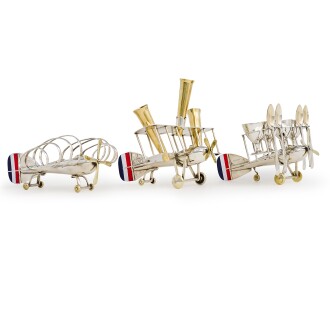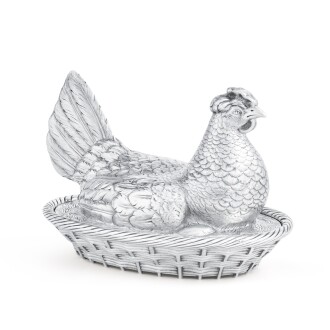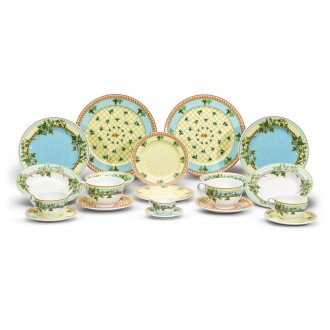F ollowing its warm reception last year, Sotheby’s Easter Feast sale returns this April with a selection of silver, porcelain and Russian works of art to celebrate the holiday in style.
Start off the day with a Victorian silver breakfast service (complete with egg cruet), skillfully crafted to resemble wicker baskets. An Easter lunch is a wonderful opportunity to get together with family, and a Royal Copenhagen ‘Blue Lace’ service is ideal for the occasion with its elegant and delicate hand-painted decoration. A perfect way to add a touch of Easter fun to the table is with a selection of porcelain eggs from the Imperial Porcelain Factory in St. Petersburg. Or, if subtlety is perhaps not quite your thing, then a fourteen inch high model of a chicken would certainly be a centerpiece high up the pecking order!
Sale Highlights

Easter and spring have traditionally been seen as times of renewal and rebirth, and this is often symbolized by chickens and eggs. This year’s Easter Feast sale features a clutch of pieces in this vein, from a spectacular silver egg holder in the form of a brooding hen to a magnificent foot-high model of a cockerel.

Baking enthusiasts have been at a loss to trace the origins of the hot cross bun: a small round cake made from a mixture of sweetened dough mixed with cinnamon and sultanas or currants, the top marked with a cross and best served toasted with lots of melted butter. Delicious! Most historians agree that they recall the religious observances of our ancestors, when such buns were eaten at Easter. The early 18th century inhabitants of London grew increasingly accustomed to hearing on Good Friday morning the cries of street sellers:
One a penny, two a penny, hot cross buns;
One for your daughters, and two for your sons:
One a penny, two a penny, hot cross buns.

Such vendors, who were mostly young boys, had the reputation for being very noisy, vying with one another to attract as much attention as possible. Some individuals of a pious nature objected to the trivialising of such a symbol, but others were less harsh in their judgement. A correspondent writing to the editor of The Morning Post in 1826 defended the vendors’ exuberance: ‘The rising generation, particularly the infant portion of it, expects cross buns as ardently and sincerely, as they expect to be washed, combed, and dressed. Bless their little hearts! . . . Whatever, therefore, the origin of cross buns, the intention manifested by them is good; no argument is so powerful as that which gratifies the taste and liking of man or child; let cross buns be cried about as usual.’
Plenty of households prepared their own cross buns, but for those who didn’t or preferred not to buy them on the streets, there were many bakers’ shops which catered for this annual demand. One was George Woolls, pastry cook and confectioner at the Denmark Arms, Westminster Bridge Road, Lambeth. In his advertisement in The Gazetteer and New Daily Advertiser in March 1782 he broadcast a long list of his specialities, including ‘Hot Pies of several sorts, and all sorts of Pastry, with Orgeat, Capillaire, Lemonade, &c. . . . Wedding and Christening Cakes of any price [and] The right sort of Dublin Saffron Cakes, and the noted Denmark Loaves.’ Woolls informed his prospective customers that he was well placed to serve anyone going to and from Astley’s famous amphitheatre, where equestrian and other circus entertainments thrilled generations of Londoners. ‘N.B.,’ he added,‘ On Good Friday will be made the best CROSS BUNS, wholesale and retail.’
Sad to relate that in the early years of the last century, the production of hot cross buns was viewed with little favour in the baking trade, largely because the making of these ‘delectable dainties’ required so such extra labour and expense. Machinery came to the rescue, however; in 1901 at Atkins Brothers & Cox’s factory in Earl Street, Hastings, Sussex, a reporter discovered a new patent draw-plate oven capable of producing 30 penny buns at a time. That year the firm ramped up its production over previous Easter seasons by delivering by the cartload some 50,000 hot cross buns across the locality.
Nobody knows how many hot cross buns are made today but, having lost none of their old-fashioned, spicy/buttery appeal, the number must run into many millions.
Read Less




















